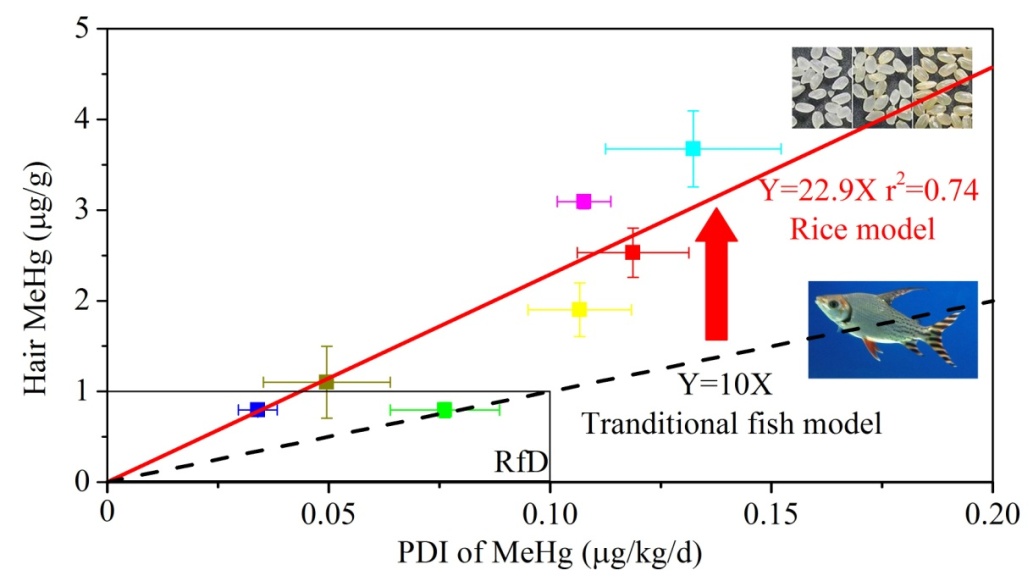 |
| Figure 1 Relationship between hair MeHg and the PDIs of MeHg via rice consumption at different sites. (Image by IGCAS) |
The toxicity of methylmercury (MeHg) has caused widespread public human concern as a result of several widely publicized disasters. MeHg is highly toxic, and the nervous system is its principal target tissue for humans. The general population is primarily exposed to MeHg through contaminated fish and marine mammals. Recent studies have highlighted the fact that rice can accumulate high levels of MeHg in mercury mining areas in Guizhou, Southwestern China (Qiu et al., 2008). Rice, rather than fish, is the main route of human MeHg exposure in the Wanshan Hg mining area (Feng et al., 2008), Guizhou Province (Zhang et al., 2010), and inland area of southern China (Li et al., 2012).
However, the current risk assessment paradigm for MeHg exposure is only based on epidemiological data collected from fish-consuming populations. On the basis of the studies conducted in the Faroes Islands (cord blood Hg concentration of 58 μg/L), USEPA set the limit of 0.1 μg/kg/day as the reference dose (RfD) for MeHg. According to the calculations made in the Faroe Islands study and in another from the Seychelles (12 μg/g Hg concentration in maternal hair), the Joint FAO/WHO Expert Committee on Food Additives (JECFA) established a provisional tolerable weekly intake (PTWI) for MeHg at 1.6 μg/kg/week. The physiologically based pharmacokinetic (PBPK) model and the one-compartment model have been used to link intake dose and blood concentration. The hair Hg concentration (H, μg/g) can be expressed as “H=10d” and “d” is daily intake of MeHg (μg/kg/day) (USEPA, 1997).
Nevertheless, Rice lacks many of the beneficial micronutrients associated with fish (e.g., n-3 long-chain polyunsaturated fatty acid (n-3 LCPUFA), selenium (Se), and essential amino acids), therefore, the current RfD and PTWI from fish consumption may underestimate the health effects of MeHg exposure from rice consumption.
The research group led by FENG Xinbin at the Institute of Geochemistry, Chinese Academy of Sciences (IGCAS) evaluated the relationship between dietary MeHg intake and human body burden in a rice-consuming population from the Wanshan Hg mining area in China.
A significant positive correlation was obtained between human hair MeHg concentrations (H) and the probable daily intakes (PDIs) of MeHg via rice consumption (d) at the different sites with the regression equation quantified as H= 22.9d. The corresponding reported model for a fish-eating population is H=10d. In practical terms, this means that an RfD of 0.1 μg/kg/day corresponds to a hair MeHg concentration of 1 μg/g. The regression coefficient for the model derived from the study was 2.3 times greater than that for the fish model, indicating that hair MeHg levels are highly elevated at the same exposure dose for the population consuming MeHg-contaminated rice relative to fish.
The toxicokinetic model of MeHg exposure based on fish consumption underestimated the human hair MeHg levels, and this may be a consequence of the high hair-to-blood MeHg ratio (361 ± 105) in the studied rice-consuming population. The use of risk assessment models based on fish consumption may not be appropriate for inland mining areas where rice is the staple food.
The findings obtained in this study can be used to advise human MeHg exposure and risk assessment through rice consumption in the Hg-polluted areas where rice is a staple food.
The above work was funded by the National Key Basic Research Program of China (2013CB430004) and the National Natural Science Foundation of China (21007068, 41120134005, and 41373135), and was published in the journal “Environ. Sci. Technol.”: Li P., Feng X.B.,* et al., Human Body Burden and Dietary Methylmercury Intake: The Relationship in a Rice-Consuming Population. 2015, 49, 9682-9689, DOI: 10.1021/acs.est.5b00195.
Furthermore, FENG Xinbin group found that the residents in Wanshan Hg mine were also exposed to inorganic Hg (IHg) and the population lived within 3 km to the mine waste heaps showed high Urine Hg (UHg) concentrations. A significantly positive correlation between paired results for UHg concentrations and serum creatinine (SCr) was observed. There are also significant increases of SCr in two quartiles with high UHg concentrations. The results indicated that human IHg exposure may cause impairment of renal function. The dietary intake is the main pathway of IHg exposure for the local population, rather than inhalation of Hg vapor. The results were published in the journal “Environmental Research”: Li P., et al., Human inorganic mercury exposure, renal effects and possible path ways in Wanshan mercury mining area, China. 2015, 140: 198-204.
(By Li Ping)